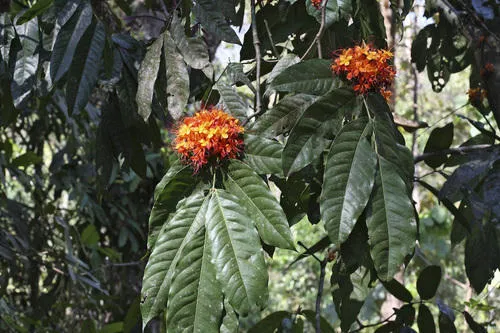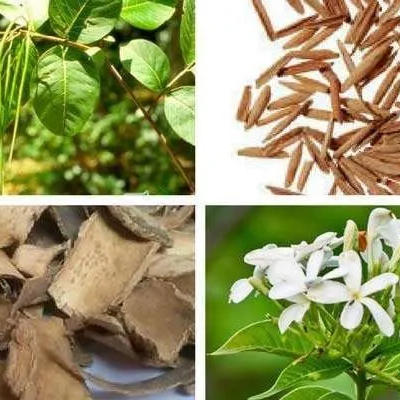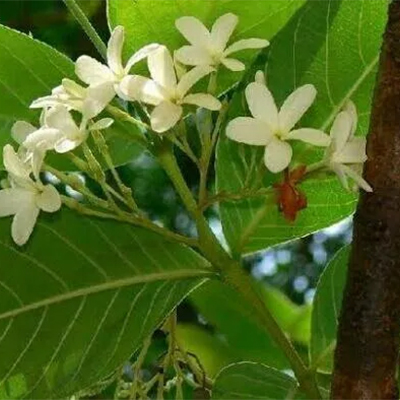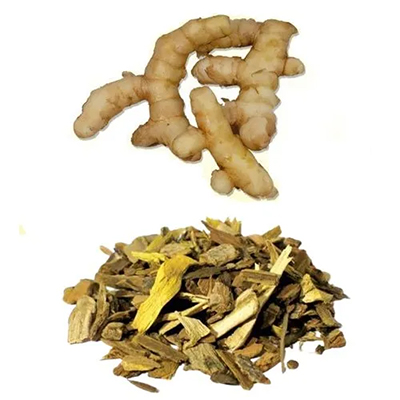On This Page
Ashoka (Saraca asoca) – A Boon for a Gynecological Disorder
Introduction
Ashoka botanically known as Saraca asoca is an auspicious tree with various medicinal properties. Saraca asoca is a vulnerable species that is becoming rarer in its natural habitat but is cultivated throughout India. Saraca asoca is a sacred plant for Hindus as it is worshiped every year on the 27th of December for the Hindu God of love Kamadeva. Also, it was believed that Gautam Buddha the founder of Buddhism was born under this tree. The word Ashoka is derived from the Sanskrit word A and Shoka which give it the deep meaning that is freedom from grief or one that helps to achieve happiness. Ashoka trees consist of various chemical constituents like glycosides, tannins, saponins, flavonoids, etc due to which Ashoka tree exhibits various properties like oxytocic property, anti- implantation, anti-bacterial, anti-cancerous, uterine tonic activities, etc.
Basonym of Ashoka
न शोको अस्मात शोक नाशन इत्यर्थ: ।
It relieves pain and patients get relief from many health problems.
Synonyms of Ashoka
- According to morphology
गंध पुष्प- सुगन्धि पुष्प त्वात ।
The flowers of Ashoka are aromatic.
ताम्र पल्लव – ताम्र वर्णा: पल्लवा अस्य।
Tender leaves are coppery red-colored.
पिण्ड पुष्प – पिण्डाकार: सघना: पुष्प गुच्छा अस्य।
The inflorescence is corymb i.e globose.
मधु पुष्प: – मधौ वसन्ते पुष्पयति।
Plant flowers in Basant Ritu (spring season).
हेम पुष्प: – स्वर्णाभानि पुष्पाणि अस्य।
Flowers are golden colored.
- According to properties and actions:
स्त्री प्रिय: – स्त्रीणां प्रिय: स्त्री रोगेषु हित त्वात।
Women like this plant or Ashoka is useful in Stri Roga (Gynecological disorder).
कंकेली – कं सुखम केलती जनयति आह्यदकर: ।
It generates happiness.
Regional names of Ashoka
- Kankeli (Sanskrit)
- Ashoka (Assamese)
- Ashoka (Bengali)
- Ashoka (Gujarati)
- Ashoka (Hindi)
- Ashokadamara (Kannada)
- Ashok (Kashmiri)
- Asokam (Malayalam)
- Ashok (Marathi)
- Ashoka (Oriya)
- Ashok (Punjabi)
- Asogam (Tamil)
- Asocapatta (Telugu)
Botanical Name
Saraca asoca Roxb.
Saraca indica Linn.
Here Saraca is named after Dr. Sarasin who was a French physician.
Asoca is derived from the Sanskrit word that means without sorrow.
Indica means native to India.
Family
Caesalpiniaceae/ Fabaceae (Putikaranja Kula)
Ayurveda reference for Ashoka (Saraca asoca Roxb.)
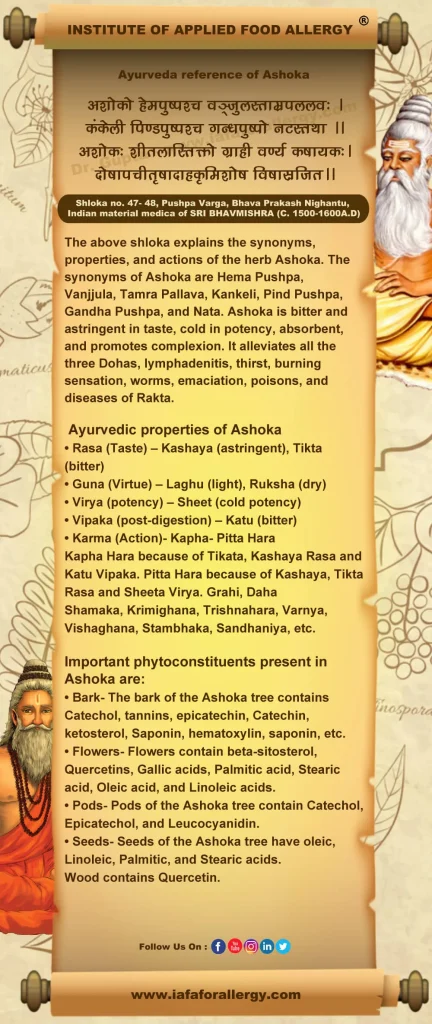
Scientific classification of Ashoka
| Kingdom | Plantae |
| Class | Dicotyledons |
| Subclass | Monochlamydeae |
| Series | Calyciflorae |
| Order | Rosales |
| Family | Caesalpiniaceae (Fabaceae) |
| Genus | Saraca |
| Species | asoca |
Classification of Ashoka as per Charaka and Sushruta
- Charaka: Vedna Sthapana Maha Kshaya, Kashya Skandha
- Sushruta: Rodhradi Gana
Ashoka’s description in Brihtrayi
| Charaka | Shusruta | Vagbhata
(Ashtang Hridya) |
| C. S. Su. 4/ 47 | S. S. Su. 6/ 28 | A. H. Chi. 3/ 10 |
| C. S. Vi. 8/ 151 | S. S. Su. 38/ 13 | A. H. Chi. 21/ 34 |
| S. S. Chi. 1/ 85 | ||
| S. S. Chi. 4/ 27, 32 | ||
| S. S. Ka. 5/ 70 | ||
| S. S. Ka. 6/ 20 | ||
| S. S. U. 17/ 8 | ||
| S. S. U. 39/ 232 |
Ashoka’s description in Brihtrayi as Gata Asoca synonym:
Vaghbhatta: A. H. Su. 15/ 26
Historical background of Ashoka
A clear description from Atharva Veda Parisista indicates that Ashoka is known to Indians since Vedic literature. It is also mentioned that Asoka bears red flowers (A. Pa. 21/7/3). Charaka described it as an anodyne while Shusruta mentioned it under Rodradhi Gana. In the earlier texts, it is not described as Pradara/ Rakta Pradara. Vrinda Madhava for the first time indicated it in Rakta Pradara. Ashoka is having a styptic property like ergot preparations, and it exhibits potent oxytocin-like activity. Therefore, one must be cautious while using its bark in therapeutics. Fortunately, it is being adulterated with the barks of Polyalthia longifolia or Shorea robusta, or Bauhinia variegata and therefore the side effects with larger doses are not reported. Vanjula is supposed to be the synonym of Asoka as well as Tinisha. Under Nyagrodhadi Gana it will be wise to accept Vetasa instead of Ashoka. Salix caprea Linn is identified with Vetasa by Bapalalji. At present, P. longifolia is popular as an Asoka tree since it is widely grown in the gardens, but it is false (Nakali) Ashoka.
External morphology of Saraca asoca
Ashoka is a tree that grows 6-9 meters in height, with glabrous branches.
- Leaves- Leaves of Ashoka tree are 15-20 cm long, compound leaves, rachis glabrous, corky at the base, petioles very short, stipules are interpetiolar, completely united.
- Leaflets- Leaflets of the Ashoka tree are 4-6 in pairs, 10-20 cm long and 4-7 cm wide, oblong-lanceolate, obtuse, or acute, glabrous, base rounded, or cuneate, slightly oblique, petioles 4-6 mm long, stout, wrinkled.
- Inflorescence- The inflorescence of the Ashoka tree is Axillary corymb.
- Flowers- Flowers in the Ashoka tree are numerous, fragrant, 7.5-10 cm across, peduncles stout, pedicels 8-13 mm long, red, glabrous, bracts ovate, subacute, bracteoles 2, appearing like a calyx, 4 mm long, calyx passing from yellow to orange and finally red. Tube 1.3-2 cm long, cylindrical, solid at the base, segments 4, oblong or obovate-oblong, 1 cm long. Stamens 7 or 8 ovaries are pubescent.
- Fruit- The fruit of the Ashoka tree is in pod shape, black, 10-25 cm long, 4.5-5 cm wide, linear-oblong, tapering to both ends, compressed, and glabrous.
- Seeds- 4-8, ellipsoid-oblong, 3-8 cm long, slightly compressed.
Flowering and fruiting time
Flowering occurs from March to April and fruiting occurs between August to September.
Distribution of Ashoka
Saraca asoca is found in the Eastern Ghats and the Western Ghats, including Orissa, Maharashtra, Karnataka, and Kerala. The tree is also grown in gardens, throughout India for its attractive bunches of sweetly scented flowers and shade.
Do you know?
Saraca indica Linnaeus is generally mistaken for Saraca asoca (Roxb.) de Wilde, the real Indian Ashok Tree. The former with bracteoles spreading on the pedicel and falling off at length is said to belong to Siam, Malaya, Sumatra, and Java, whereas the latter with erect bracteoles clasping the pedicel is found only in Sri Lanka, India, and Bangladesh. However, since both are closely related, it is worthwhile studying the usefulness of the bark of Saraca indica as a substitute for Saraca asoca whose demand is enormously increasing day by day.
The useful part of Ashoka
Bark, Seed & Flowers.
Bark: The bark of the Ashoka tree is curved, channeled, or sometimes quilled pieces, 5 to 12 mm in thickness. The outer surface is rough, greyish brown, covered with warty protuberances, and enclosing circular to transversely elongated lenticels. The inner surface of the bark is smooth reddish-brown and finely mottled with black dots. The transversely cut surface shows long, radially elongated but irregularly running medullary rays. It is tough to break and becomes fibrous. Ashoka tree bark doesn’t possess any characteristic odor.
Important phytoconstituent of Ashoka
- Bark- The bark of the Ashoka tree contains Catechol, tannins, epicatechin, Catechin, ketosterol, Saponin, hematoxylin, saponin, etc.
- Flowers- Flowers contain beta-sitosterol, Quercetins, Gallic acids, Palmitic acid, Stearic acid, Oleic acid, and Linoleic acids.
- Pods- Pods of the Ashoka tree contain Catechol, Epicatechol, and Leucocyanidin.
- Seeds- Seeds of the Ashoka tree have oleic, Linoleic, Palmitic, and Stearic acids. Wood contains Quercetin.
Substitution and adulteration of Ashoka
Polyalthia longifolia are very commonly used as Ashoka. Shala i.e Shorea robusta is the common substitute for Ashoka.
The bark of the Ashok tree is sometimes mixed with Rohitaka bark and Caesalpinia pulcherrima.
Recent research on Ashoka
- Saraca asoca methanol extract was capable of ameliorating the conditions of arthritis in adjuvant-induced arthritic rats. Saravanan S, Babu NP, Pandikumar P, Ignacimuthu S. Therapeutic effect of Saraca asoca (Roxb.) Wilde on lysosomal enzymes and collagen metabolism in adjuvant-induced arthritis. Inflammatory Pharmacology. 2011 Dec; 19(6):317-25. Epub 2011 Sep 23
- Flavonoids of Saraca asoca showed chemopreventive activity on 2-stage skin carcinogenesis. Cibin TR, Devi DG, Abraham A. Chemoprevention of Two-stage Skin Cancer in Vivo by Saraca asoca. Inter Cancer Ther. 2011 Jul 19.
- The phytochemical analysis of the promising methanolic extract of the seed extract was positive for carbohydrates, saponins, terpenoids, tannins, and proteins. Bioassay-guided fractionation of effective extracts may result in the identification of a useful molecule for the control of mosquito vectors. Mathew N, Anitha MG, Bala TS, Sivakumar SM, Narmadha R, Kalyanasundaram M. Larvicidal activity of Saraca indica, Nyctanthes arbor-tristis, and Clitoria ternate extracts against three mosquito vector species. Parasite Res. 2009 Apr; 104(5):1017-25. Epub 2008 Nov 28.
- Extracts of Saraca asoca contain antibacterial agents. Shahid M, Shahzad A, Malik A, Anis M. Antibacterial activity of aerial parts as well as in vitro raised Calli of the medicinal plant Saraca asoca (Roxb.) de Wilde. Can J Microbiol. 2007 Jan; 53 (1): 75-81.
- The antimicrobial potential of seventy-seven extracts from twenty-four plants was screened against eight bacteria and four pathogenic fungi, using micro broth dilution assay. Water extracts of Acacia nilotica, Justicia zeylanica, Lantana camara, and Saraca asoca exhibited good activity against all the bacteria tested. Dabur R, Gupta A, Mandal TK, Singh DD, Bajpal V, Gurav AM, Lavekar GS. Antimicrobial activity of some Indian medicinal plants. Afr J Tradit Complement Altern Med. 2007 Feb 16:4(3):313-8.
- The commonly used adulterant is the bark of Polyalthia longifolia which shows some similarity with that of Asoka. Studies were conducted at the Aromatic and Medicinal Plants Research Station, Odakkali (Kerala Agricultural University) from 2001-to 2002 to evolve methods for differentiating the original drug from the adulterant species by anatomical biochemical and chromatographic techniques. Mathew S, Mathew G, Joy PP, Skari BP, Joseph Ts. Differentiation of Saraca asoca crude drug from its adulterant, Ancient Sci Life. 2005 Apr; 24(4): 174-8.
- Antimicrobial
- Anti- menorrhagia
- Anti- oxytocic
Rasa Panchaka of Ashoka
| Rasa (Taste) | Kashaya (astringent), Tikta (bitter) |
| Guna (Virtue) | Laghu (light), Ruksha (dry) |
| Virya (potency) | Sheeta (cold potency) |
| Vipaka (post-digestion) | Katu (pungent) |
Dosha Karma of Ashoka
Kapha- Pitta Hara
Kapha Hara because of Tikta, Kashaya Rasa and Katu Vipaka.
Pitta Hara because of Kashaya, Tikta Rasa, and Sheeta Virya.
Karma (Actions) of Ashoka
Grahi, Daha Shamaka, Krimighana, Trishnahara, Varnya, Vishaghana, Stambhaka, Sandhaniya, etc.
Prayogarha Vyadhi (Therapeutic indication) of Ashwagandha
- Pradara
- Yonivyapata
- Daha
- Krimi
- Vrana
- Trishna
- Shosha
- Apachi
- Arsha
- Visha Roga
- Gulma
- Udara Shoola
- Aadhmana
- Vaivarnya
Aamyik Prayog (Therapeutic uses) of Ashoka
Pradara (Meno-metrorrhagia)- Cold milk (Sheeta Dugdha) boiled with the decoction of Ashoka bark is given in Pradara. (Vrinda Madhava 63/ 5)
Mutraghata (suppression of urine) and Ashmari (Vesical calculi)- Asoka seed taken with water alleviates suppression of urine and calculus. (Chakra Dutta. 33/ 12)
Vatavyadh (Vataja disorder)- Shusruta prescribes Asoka- Ghrita like Tilvaka Ghrita in Vata Vyadhi. (Shusruta Samhita Chiktsa Sthana. 4/ 27)
Important benefits of Ashoka
- Dysmenorrhea (Kasht Aartava): As per Ayurveda Aartava is governed by Vata Dosha, so Vata must be under control to manage dysmenorrhea. Saraca asoca with its Vata balancing properties reduces abdominal cramps and pain during the menstrual cycle.
- Piles (Arsha): The main culprit behind piles is a sedentary lifestyle, unhealthy diet, and vitiation of Tridosha, mainly Vata. Vata will lead to Vivandha (constipation) as it causes a low digestive fire. All these factors lead to swelling in the veins of the rectum area which lead to pile masses. Ashoka with its Sheet Virya and Vata balancing property reduces discomfort and burning sensation in pile mass, and anus and also relieves the swelling in the vein of the rectum area.
- Leucorrhea (Shweta Pradara): Leucorrhea occurs as a result of an imbalance in Kapha. Ashoka with its Kapha balancing and Kashaya (astringent) properties, controls aggravated Kapha and shows good results in Shweta Pradara.
- Menorrhagia (Rakta Pradara): In Rakta Pradara excessive secretion of menstrual blood occurs due to aggravated Pitta. Ashoka with its Sheet Virya (cold potency) helps to control heavy menstrual bleeding.
Matra (Therapeutic administration and dosage) of Ashoka
- Kwatha (Decoction)- 50- 100ml
- Beeja Churna (Seed powder)- 3- 6grams
- Pushpa Churna (Flower powder)- 1- 3grams

Have A Health Issue?
Consult Online
- Dr. Sahil Gupta (B.A.M.S., M.H.A.)
Ayurvedic Allergy Specialist
CEO & Founder of IAFA®
Classical reference of Ashoka:
Bhava Prakasha Nighantu Pushpa Varga- 47
Synonyms
अशोको हेमपुष्पश्च वञ्जुलस्ताम्रपललव: ।
कंकेली पिण्डपुष्पश्च गन्धपुष्पो नटस्तथा ।।
Bhava Prakasha Nighantu Pushpa Varga- 48
Action and properties
अशोक: शीतलास्तिक्तो ग्राही वर्ण्य कषायक:।
दोषापचीतृषादाहकृमिशोष विषास्रजित।।
Dhanwantri Nighantu Aamlaadi Varga, 145- 148
अशोक शोकनाशश्च विचित्र: कर्णपूरक: |
कंकेलिहिमपुष्पश्च पिंड पुष्प स तथेव च।।
गतशोको वीतशोको विशोकस्ताम्र पल्लव: ।
पिण्डीपुष्पो हेमपुष्प: सुभग: कर्णपूरक: ।।
अशोक शीतलश्च अर्श: कृमीन्हन्ति प्रयोजित: ।
अशोको मधुरो हद्य: सन्धानीय: सुगन्धिक: ।।
Kaiydeva Nighantu, Aushadi Varga, 1502- 1503
विचित्रो रक्तको रागी रामस्तवक मंजरी ।
चित्रशोकः शोकनाशः ख्रीपादहतिदोहद्: ।।
अशोको शीतल: स्निग्धो वर्ण्यो ग्राही कषायक:।
दोषापचीतृषादाहकृमिशोष विषास्रजित ।।
Raja Nighantu, Karveeradi varga, 55, 57
अशोक: शौकनाशः स्यादिशोको वजुल द्रुम: । मधुपुष्पो अपशोकश कंकलि: कलिकस्तथा।।
अशोक: शिशिरो हद्य: पित्तदाहश्रमापह: ।
गुल्मशूलोदराध्मान-नाशनः क्रिमिकारक: ।।
Priya Nighantu, Haritkyadi Varga, 174
अशोक स्तिक्तस्तुवर: शीतो वर्ण्यो विषापह: ।
स्त्रीणां प्रदररोगे च योनिव्यापत्सु शस्यते ।।
A. P. 21/ 7/ 3, Paa. G. 7/ 3/ 46
किंशुकाशोकपद्माभो नीलोत्पलनिभस्तथा। वहिसिद्धिकरो ज्ञय।
Shodhala Nighantu
अशोक: शोकनाशश्च विचित्र: कर्णपूरक: । विशोको रक्तको रागी चित्र: शत पद मंजरी।
अशोक त्वचा रक्तप्रदरस्य विनाशिनी।।
Chakra Dutta
अशोक वल्कल क्वाथ शृतं काथमृतं दुग्ध सुशीतलम् । यथाबलं पिबेतमप्रात स तीव्र असृग्दरनाशनम।।
Shusruta Samhita Chikitsa Sthana. 4/ 27
वातव्याधौ
अशोकघृतम्-
तिल्वकविधिरेवाशोकरम्यकयोर दृष्टव्य।
Vrinda Madhava. 63/ 5
प्रदरे- अशोकवल्कलक्वाथशृतं दुग्ध सुशीतलम्।
यथाबलं पिबेत् प्रातस्तीव्
Chakra Dutta. 33/ 12
अश्मरी
जलेन खदिरीबीजं मूत्राघाताश्मरीहरम्।
Specific Formulation of Ashoka
- Ashoka Arishta for Asrigdara and Raktapitta.
- Ashoka Ghrita for Pradara, Yonishool, Katishool
- Ashoka Kashaya for Swarasada
- Madhukadya Avaleha for Pradara, Raktatisara, rakta Arsha.
- Maha Marichadya Taila for Kustha
Contraindication and side effects of Ashoka
The use of Ashoka for medicinal purposes may lead to complications in pregnant women, so it is better to avoid the use of Ashoka during pregnancy. In a few cases, Ashoka’s use may lead to dizziness, nausea, headache, etc. Also, in the case of breastfeeding, constipation uses Ashoka under medical supervision.
Suggestive reading regarding Ashoka
- Dr. Shilpa, N G Shivaram, B R Lalitha, & T Chaitra. (2019). Ashoka [Saraca Asoca (Roxb.) Willd.]: A Salubrious Plant. Journal of Ayurveda and IntegraMedicalSciences, 4(05),184-190.RetrievedfromAshoka[Saraca Asoca (Roxb.) Willd.]: A Salubrious Plant | Journal of Ayurveda and Integrated Medical Sciences
- Bisht A, Irshad S, et al. Pharmacognostical studies on Saraca asoca (Roxb.) Willd. flower. Tropical Plant Research. 2017 Apr 30;4(1):153–60
- Jana, B & Thenmozhi, S & Suja, M & Rajan, Suyambu & Thiyagarajan, Thirunalasundar. (2012). Pharmacognostical and phytochemical studies of An Ayurvedic drug Saraca asoca stem bark. B Jana, S Thenmozhi, M Suja, S Rajan, T Thirunaal sundari Journal of Pharmacy Research 5 (2). The Journal of Pharmacy. 5. 1119-1121.
- Baranwal, Vandana. (2014). Asoka: Herbal Boon to Gynecological Problems an Overview of Current Research. Light on Ayurveda- Journal of Health. 15. 58-62.
- S. Kumar, S. Narwal, D. Kumar, G. Singh, S. Narwal, R.Arya, 2012, Evaluation of Antihyperglycemic and antioxidant Activities of Saraca Asoca (Roxb.) De WildLeaves in Streptozotocin-Induced Diabetic Mice, AsianPacific Journal of Tropical Disease 03/2012; 2(3): 170-76.DOI: 10.1016/S2222-1808(12)60041-3.
- Aditya Mishra, Anil Kumar, Neelam Rajbhar, Ashok Kumar, Phytochemical and Pharmacological Importance of Saraca indica, International Journal of Pharmaceutical and Chemical Sciences, ISSN: 227, 5005, p. 1010.
- S. Nayak, A.M. Sahoo, C.K. Chakraborti, 2011, Phytochemical Screening & Anthelmintic Activity Study of Saraca indica leaves extracts, IRJP, 2(5): 194-97.
- S.C. Pal, A.P. Maiti, B.P. Chatterjee, A. Nandy, 1985, Antibacterial Activity of Flowers & Flower Buds of SaracaIndica Linn, Ind J Med Rec, 82(2): 188-89
- Begum SN, Ravikumar K, Ved DK (2014) Asoka’ – an important medicinal plant, it’s the market scenario and conservation measures in India. Curr Sci 107:26–28
- Singh S, Krishna TH, Kamalraj S, Kuriakose GC, Valayil JM, Jayabaskaran C (2015) Phytomedicinal importance of Saraca asoca (Ashoka): an exciting past, an emerging present and a promising future. Curr Sci. 109:1790–1801.
- Adangam Purath Shahid, Nanu Sasidharan, Sasidharan Salini, Jose Padikkala, Nair Meera, Achuthan Chathrattil Raghavamenon, Thekkekara Devassy Babu, Kingiodendron pinnatum, a pharmacologically effective alternative for Saraca asoca in an Ayurvedic preparation, Asokarishta, Journal of Traditional and Complementary Medicine, Volume 8, Issue 1, 2018, Pages 244-250, ISSN 2225-4110.
References
- Agnivesha, Charaka, Dridhabala. In: Charaka Samhita, ed. Vaidya Jadavaji Trikamji Aacharya., editor. Varanasi: Chaukhamba Sanskrit Sansthan; 2009.
- Sushruta. In: Sushruta Samhita, Sutra Sthana, ed. Vaidya Jadavji Trikamji Acharya., editor. Varanasi: Choukhambha Orientalia; 2005.
- Vagbhata. In: Ashtanga Hrudaya, 9th ed. Anna Moreshwar Kunte, Krishnashastri Navarre, Harishastri, editors. Varanasi: Choukhambha Orientalia; 2005.
- Bhavamishra. In: BhavaPrakasha Nighantu, Pushpa Varga 11th ed. part 2. Brahma Shankara Mishra., editor. Varanasi: Choukhambha Bharati Academy; 2009.
- Bhavprakasha, commentary by Bulusu Sitaram, forwarded by K.C.Chunekar
- Sharma PV, Kaideva Nighantu. Aushadhi Varga. Chaukhamba Orientalia, Varanasi; 2006:
- Tripathi I., Raja Nighantu, Karveeradi Varga, Chaukhamba Krishnadas Academy; Varanasi; 2010
- Dhanwantri Nighantu, Aamladi Varga
- P.V. Sharma, Priya Nighantu, Haritkyadi Varga, Chaukhamba Krishnadas Academy; Varanasi.
- Dr. Gyanendra Pandey, Dravyaguna Vigyana, reprint 2012, Chawkhamba Krishnadas Academy
- K. Niteshwar Dravyaguna Vigyan, reprint 2017.
- Dr. J.L.N. Sastry and Dr. B.S. Sastry, Dravyaguna Vigyana, Chaukhambha Orientalia, Varanasi.
- Chakrapanidatta, Chakradatta with the vaidaya Prabha hindi commentary by indra deva tripathi, chaukambha sankrita sansthan, varanasi 2nd Edition, 1994.
Ayurveda is an Indian system of medicine that is popular since ancient times. Dr. Gupta’s IAFA® has been conducting research studies to find out different phytoconstituents of herbs and their action in the body. Such knowledge acquired by our experts is used in the preparation of medicines and providing the treatment facilities safely and effectively. IAFA® is the provider of safe and effective treatment for a wide range of diseases, mainly allergic diseases all based on Ayurveda.

